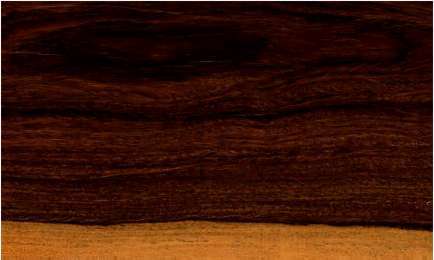
Lignumvitae (Guaiacum spp.)
Family: Zygophyllaceae
Common names: Guayacan, Lignumvitae, Palo santo
Distributed in: Bahamas, Columbia, Costa Rica, Cuba, Dominican Republic, El Salvador, Guatemala, Haiti, Jamaica, Mexico, Nicaragua, Panama, United States, Venezuela (Central America)
Distribution overview: West Indies, coastal region of tropical Mexico, west coast of Central America, and northern fringe of Colombia and adjacent areas in Venezuela. Largely confined to dry exposed sites and does well on shallow soils.
Common uses: Bearings & bushings, Bushing blocks, Farm vehicles, Machinery parts, Naval architecture, Pulley sheaves, Textile equipment, Turnery, Wheels
Product sources: Lignum vitae is available in the form of small logs and is sold by weight. The material is typically marketed in pre-fabricated shapes for specific uses, and rarely in lumber form.
Environment profile: Source- Convention of International Trade in Endangered Species -CITES
Tree size: Trunk diameter is 200-250 cm
Colors: the heart isPink, Redand the sapwoodWhite, Yellow.The grain isVery irregular and roey, the textureVery fineand the lusterHigh
Natural durability: Resistant to termites, Susceptible to insect attack
Odor: May have a mild taste
The timber is slightly scented when it is warmed or rubbed, and the taste has been decsribed as slightly acidic
Silica Content: Siliceous
Kiln Schedules: T2 - C2 (4/4) T2 - C1 (8/4) US/T2 - C2 (4/4) T2 - C1 (8/4) U
Kiln Drying Rate: Naturally dries slowly
Drying Defects: Shakes, Splitting
Ease of Drying: Slowly
Comments: Lignum vitae is reported to produce some of the heaviest and hardest timbers on the market. Strength properties are very high, and the wood is unequalled as material for ships' propeller bushings and bearings. The timber is reported to last about three times as long as steel or bronze for these applications because of its self lubricating properties.SplittingStraight grained material is difficult to split radially
Blunting Effect: Moderate
Boring: Fairly easy to very easy
Carving: Poor response to carving operations
Cutting Resistance: Easy to saw
The timber is very hard and heavy, and the heartwood is very difficult to saw. The sapwood is much less hard and brittle
Gluing: Use special attention for best results
Mortising: Fairly Easy to Very Easy
Moulding: Fairly Easy to Very Easy
Movement in Service: Fairly Easy to Very Easy
Nailing: Fairly Easy to Very Easy, Poor to Very Poor
Planing: Very Good to Excellent
Resistance to Impregnation: Resistant sapwood
Response to hand tools: Responds Readily
Routing recessing: Poor routing characteristics
Sanding: Very Good to Excellent Results
Veneering qualities: Suitable for slicing, Veneers easily
Screwing: Fairly Easy to Very Easy, Pre-boring recommended; Turning: Fairly Easy to Very Easy
Polishing: Very Good to Excellent; Staining: Fairly Easy to Very Easy;
- Numerical data Metric
- Numerical data English
- Strength properties
- References
 |
 |
 |
 |
| Item |
Green |
Dry |
Metric |
| Specific Gravity |
0,97 |
1,15 |
|
| Density |
|
1233 |
kg/m3 |
| Bending Strength |
|
|
kg/cm2 |
| Crushing Strength |
|
785 |
kg/cm2 |
| Hardness |
|
2000 |
kg |
| Impact Strength |
|
|
cm |
| Shearing Strength |
|
|
kg/cm2 |
| Stiffness |
|
|
1000 kg/cm2 |
| Tangential Shrinkage |
|
|
% |
| Radial Shrinkage |
|
|
% |
| Weight |
|
|
kg/m3 |
| Maximum Load |
|
|
cm-kg/cm3 |
| Toughness |
|
186 |
cm-kg |
| Static Bending |
|
|
kg/cm2 |
|
 |  |  |  | | Item | Green | Dry | English | | Density | | 77 | lbs/ft3 | | Hardness | | 4410 | lbs | | Maximum Crushing Strength | | 11172 | psi | | Toughness | | 162 | inch-lbs | | Specific Gravity | 0.97 | 1.15 | | | Weight | 74 | 61. | lbs/ft3 | |
Boone, R.S., C.J. Kozlik, P.J. Bois, E.M. Wengert. 1988. Dry Kiln Schedules for Commercial Hardwoods - Temperate and Tropical. USDA, Forest Service, General Technical Report FPL-GTR-57, Forest Products Laboratory, Madison, Wisconsin.Chudnoff, M.,1984,Tropical Timbers of the World,U.S.A. Department of Agriculture, Forest Service, Forest Products,Laboratory, Madison.Jackson, A. and D. Day.1991.Good Wood Handbook - The Woodworker's Guide to Identifying, Selecting and Using the Right Wood.Betterway Publications, Cincinnati, Ohio.Kline, M. 1976. Guaiacum officinale - Lignumvitae. In A Guide to Useful Woods of the World. Flynn Jr., J.H., Editor. King Philip Publishing Co., Portland, Maine. Page 178-179.Little, E.L.1980.The Audobon Society Field Guide to North American Trees - Western Region.Published by Arthur A. Knopf, New York.
|








